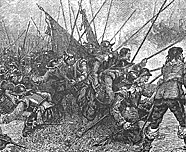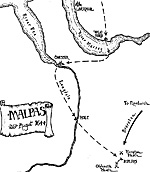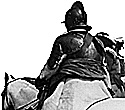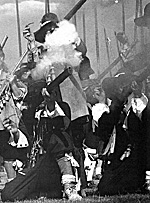
Background
The great Royalist defeat at Marston Moor (July 2nd 1644) led to the effective disintegration of much of the Northern Royalist Army of the Marquess of Newcastle. However, about 2,500 horse, the remnants of over a score of Newcastle's old cavalry units, reinforced bv assorted reformadoes, remained in the field under the command of the redoubtable Sir Marmaduke Langdale.
Prince Rupert hoped at first to employ these troops, soon to be known as the Northern Horse, as the foundation of an attempt to stage a counteroffensive in the North, but, after the surrender of York on July 16th, preceded by Newcastle's departure to exile on the Continent, but the schemes proved increasingly fruitless.
Rupert now planned to use the Northern Horse, who had been recruiting and foraging in Cumbria, to bolster the Royalist Forces under Lord Byron, which were attempting to hold on to the Prince's recent conquests in Lancashire. These hopes soon proved equally illusory.
At the best of times, the cavalry of Newcastle's army had not been noted for their discipline and observance of the niceties of life, and the disaster at Marston Moor had left them in bitter and truculent mood. Their rapacious journey through Lancashire, accompanied, as was their custom, by large herds of looted livestock, and by various camp followers, including their notorious "leaguer ladies," served only to alienate the local populace.
Despite his natural bias, there is no doubt that the Lancashire Parliamentarian Edward Robinson was correct when he commented: "Gladd was the Countrv soe to be free of them, though most were gladd at their coming." (1)
Byron had hoped that Langdale's force, combined with the Lancashire Royalist cavalry brigade of Lord Molyneux, would provide an effective counter to the Parliamentarian forces under Sir John Meldrum, based on Manchester, which were becoming increasingly aggressive. (2)
But Langdale proved to be operating to an agenda of his own. He described his intentions in a letter to Prince Rupert "We resolved that there was noe hope to continue in Lancashire and in Westmoreland would be as ill and Cheshire in the same condition so that it was held the best to
advance to the Kinge who if he get the better would be in a better condition to relieve these northerne counties, that are totally lost by this dessertion which cannot be better mended than by a speedy returne of Your Highness into those counties." (3)
The outcome was, that when on August 21st Meldrum caught up with the disputing Royalists just south of Ormskirk, Langdale drew off the Northern Horse virtually without striking a blow, leaving Molyneux's brigade to be badly mauled. (4)
The Northern Horse, shedding Molyneux's "much shattered" brigade at Chester, quartered for a few days on the Welsh side of the River Dee, finding great difficulty in obtaining sufficient
fodder for their horses, before, to Byron's disappointment but the local inhabitants, considerable relief, resuming their southwards march, probably crossing the River Dee back
into England at Holt Bridge.
The decision which had been reached by Langdale and his officers had not been accepted by many of their troopers. An evidently considerable flow of desertions was underway, and many of the Northern Horse headed back through Lancashire "in small and great companies," harassed by
local Pardiamentarian forces (5). It seems clear that the rank and file of Langdale's force were in a state not far from mutiny, and this had an important bearing on events to fo1low.
Unfortunately for the Royadists, the war in Cheshire had just taken a decided turn in Parliament's favour. On August 21st Sir William Brereton's forces had eased a notable thorn in their flesh when they had defeated Colonel John Marrow's Regiment of Horse at Tarvin, and
mortally wounded its redoubtable commander. (6)
News of the Royadist move had reached Brereton at his headquarters in Nantwich on the night of Saturday, August 24th, and when, on the evening of August 25th, Langdale quartered in and around the small town of Malpas, some 5 miles north-west of Whitechurch, the Parliamentarian commander was already preparing his countermoves.
Brereton had, in fact, been caught at some disadvantaage. He was fresh1y returned from a meeting in Lancashire with Sir John Meldrum, and the bulk of the Cheshire horse, still re-organising after their victory at Tarvin, were quartered around Middlewich, 11 miles to the northeast. However, Brereton hastily mustered what troops he could, and prepared for action.
The fulllest account of the battle is contained in Brereton's own dispatch,
although he is annoyingly vague on some details, including its exact location.
Though some accounts state that the fighting took place on No Man's
Heath, about a mile east of Malpas, the local Parliamentarian writer, Thomas
Malbon, who was in a position to know. states that the action was on Oldcastle
Heath. a mile to the south-east of Malpas, whilst Brereton himself says the
fighting was around hampton Heath, about a mile north-west of No Man's Heath.
Most probably skirmishing occurred at all of these places at various stages
in the fighting, with the action referred to by Malbon forming the second phase
of the battle.
Sir William Brereton takes up the story: "Two or three of our troops came
not in, which made the assault heavier upon the rest; which, together with some
seven companies of our foot (whereof three or four were of my own regiment,
one of Col. Brooke's, and the rest of Colonel Duckenfield's Regiments),
marched out of nantwich upon Sabbeth Day, in the evening. about six of the
clock. and called to Malpas the next morning about the spring of day, where my
troop charged the enemy three or four times, the other troops which followed not
being able to come up in the narrow lanes.
the enemy were judged to be about forty colours, and betwixt two and
three thousand in number: The commanders thereof, being many of them
Papists (for this was the remainder of the Earl of Newcastle's army sometime
commanded by Goring), did fight and come on very gallantly, as Lt. Col. Jones,
CaptainSankey, Captain Finch, Captain Church, Lt. burroughs, and divers
others.(7)
When we came to the top of the hill, (around Hampton Heath), we discovered
the enemy to stand in six or seven several bodies, or divisions. in very good
order. But before this time we had killed divers of their colonels and great
officers. It was not thought fit to pursue any further, we having beaten two strong
parties of them and followed them through Malpas town.
Nor was it safe to engage a hundred against so great a number. and we
could not retreat without danger of losing all. Therefore it was resolved that we
should stand in the mouth of the Lane, till the Foot came up to relieve them,
which were commanded by Major Lothian and Co. Veneables. (8)
The common soldiers, upon the losse of so many of their
officers, retreated. and we were not able to pursue them far.
But had we five hundred horse, we might (by God's blessing)
have wholly destroyed this army, whereof there may still be
ahout 2,000 remaining, which with Sir William Vaughan's
Regiment, and Colonel Trevor's, and the remainder of the
Prince's Regiment of Horse, they cannot be but above 3000.
(9)
When they were then upon their march towards
Shrewsbury, and so to the King: they fled back towards
Chester, where they could not be admitted, but were looked
UpOI1 very scornily, because they were beaten back by, so
inconsiderable a number, which they exceeded above ten-
fold.
The enemy being still numerous can overmatch us, it is not improbable they may force their passage to join with the King's army: therefore it were much to be desired that what horse and foot is intended us may be speeded unto these parts. It is uncertain where Prince Rupert is, but some say he is gone towards Shrewsbury, some say towards the King, but it is not known to many in Chester. (10)
Lord Byron, not surprisingly, considering the ill-feeling between
himself and Langdale, wrote scathingly to Prince Rupert of the
defeat: "Since Sir Marmaduke Langdale came out of Lankashire another
misfortune hath befallen his troopes which were beaten up at Malpas the
first night they quartered there by 200 horse and as many foot from
Nantwich, the officers did as much as could been, but were deserted by
theire soldiers.
Sir Mar himself is shots in the thigh and now lyes under the
chierghins hands at Chester, and God be thanked without danger. (12)
Maxey is taken prisoner and some other officers kild and taken, the
rest are marched through Wales, being in such a fright, that they are nott
yett fitt to come neere an enemy." (13)
Royalist losses were not in fact particularly heavy, but included a
number of officers. Among the dead were: Colonel Cuthbert Conyers ( a
former commander of a Regiment of Foot, probably now serving as a
reformado), Colonel William Baynes, Major Thomas Hesketh, a
Lancashire man from Rufford, possibly of Sir William Bradshaw or Sir
john Girlington's Regiment, and Major Richard Hartburn (mortally
wounded), together with, according to Brereton, up to 150 others,
including many officers.
Prisoners included: Major Thomas Cromwell (Duke of York's (Samuel Tuke's) Regt), Major William Maxey (Sir Charles Lucas H.): Maxey was in command of the regt, as both its colonel and Lt. Col. had been casualties at Marston Moor. Major Thomas Crathorne (wounded) ( John Forcer. H.) Capt. Thomas Clavering (John Forcer. H.) Captain Barker ( Duke of York. H ) Lt. Mountain (Montagne?) Some other officers and about 20 troopers were also taken.
Parliamentarian losses in the affair were extremely light, for
apart from Lieutenant-Colonel Jones, shot in that vulnerable spot,
the thigh, and some of Brereton's own troop "very slightly
wounded", the Parliamentarian account admitted to no losses.
Byron's estimate of the effect of this defeat on the Northern
Horse was entirely correct. Hopes of making a direct march to join the
King at an end, they recoiled into Central Wales, and ended up in
Monmouthshire, where they terrorised the civilian population in their
customary fashion before eventually being extricated in October
by Charles Gerrard, and joining the Oxford Army on 1st November,
having missed the Second Battle of Newbury, where their presence
might have made an important difference to the outcome of that
day.
Royalist
Northern Horse
The remains of over 20 regiments of horse from the army of the
Marquis of Newcastle. Any regimental organisation must have been
sketchy, as most of them were badly understrength even at the start ot
the campaign. Eventually (though probably not at this point) organised
into two brigades, the basic tactical unit of the Northern Horse was
probably the squadron, which may each have included elements from
several regiments. The Northern Horse included a particularly large
proportion of officers, together with their immediate servants and
personal retainers.
The Duke of York's and Sir Charles Lucas's Regiments, which
were present at Malpas, though at least in part northern units, were not
part of the Northern Horse as such, and would be detached again
before the end of the year. (l 4)
Parliamentarian
Sir William Brereton's Regiment of Horse (raised early 1643,
eventually incorporated most of the Cheshire Horse)
Sir William Brereton's Dragoons, otherwise known as his
"firelocks", these were rather more in the nature of mounted
musketeers, and included a number of ex-Royalist soldiers
from Ireland. They were highly regarded by Brereton. To
further confuse mattees, they were later part ot Brereton's
Regiment of toot, also originally raised in 1643.
Henry Brooke's Regiment of Foot. Raised Bucklow Hundred, probably early 1644.
Robert Duckenfields Regiment of foot Recruited in the Macclesfield and Stockport area early in 1643, this was one of the most experienced of the Cheshire foot regiments.
(1) 'Discourse of the warre in
Lancashire ed. William Beaumont. Chetham Society, Vol. LXII, 1864, pg
57.
 A no doubt acrimonious meeting followed near Liverpool at which, to Byron's chagrin, Langdale
reiterated his intention of marching south to join the King, and pushed on the same day over the Mersey at Hale Ford into Cheshire.
A no doubt acrimonious meeting followed near Liverpool at which, to Byron's chagrin, Langdale
reiterated his intention of marching south to join the King, and pushed on the same day over the Mersey at Hale Ford into Cheshire.
Parliamentarian Countermoves
The Battle
 But before the foot came up our horse were very much spente, whilst they
received three or four fresh charges by several Irish brigades or divisions,
wherein was neither man or one foot of ground lost, but rather gained every
charge. And when the foot came up, they performed very good execution; yet
they were all in danger to be surrounded by the enemy, who as they were
sufficently strong, so they wanted not opportunity, when God willed so
many of their commanders into our hands, who were killed, wounded and
taken prisoners, as will appear by the enclosed.
But before the foot came up our horse were very much spente, whilst they
received three or four fresh charges by several Irish brigades or divisions,
wherein was neither man or one foot of ground lost, but rather gained every
charge. And when the foot came up, they performed very good execution; yet
they were all in danger to be surrounded by the enemy, who as they were
sufficently strong, so they wanted not opportunity, when God willed so
many of their commanders into our hands, who were killed, wounded and
taken prisoners, as will appear by the enclosed.
 Lt. Colonel Jones. Capt. Zanckey. Capt. Finch. Capt. Church and
others showed much courage and resolution in standing so valiantly, not
shrinking a foot at several charges by the enemy, which did so much
amaze the enemy that some of them swore "they were devils not
men." (11)
Lt. Colonel Jones. Capt. Zanckey. Capt. Finch. Capt. Church and
others showed much courage and resolution in standing so valiantly, not
shrinking a foot at several charges by the enemy, which did so much
amaze the enemy that some of them swore "they were devils not
men." (11)
Units
Present
Note on Sources
(2) Byron to PRince Rupert,
Aug 23rd 1644 (BL AD MSSS 1898l, f.227-8, Reprinted in "Your most
humble and most obliged servant," ed John Lewis, 1995, p. 8-10
(3) Bod. Lib. Firth MSS,
C7.f.146
(4) See john barratt, "The Siege
of Liverpool and the Lancastrian Campaign 1644", 1993
(5) "Discourse" op. cit. p. 58.
(6) See Barratt, op. cit. p.21
(7) Lt. Col. Michael Jones (later
the victor of Rathmines), effective comander of the Cheshire Horse, Capt.
Jerome Zanckey, commanding Brereton's own troop, Capt. Sion Finch of
Brereton's Firelocks (an ex-Royalist, probably from the Army of ireland),
Capt. (later Major) John Church of Henry Brooke's Regt (probably a
professional soldier), Brereton himself is frequently credited by both
Royalist and Parliamentarian contemporaries with possessing a highly
developed sense of self-preservation, and it is perhaps significant that his
dispatch makes no mention of his own role in the fighting.
(8) Major gen. Jame Lothian,
the Scottish professional who led the Cheshire Foot. Lt. Col. Robert
Venables (Henry Brooke's Regt of Foot).
(9) Vaughn's, Marcus Trevor's,
and Prince Rupert's Regts of Horse were among the units based inthe
Chester area after Marston Moor. Probably the only other Royalist
cavalry formations in the vicinity immediately fit for action, they never
in fact served with the Northern Horse.
(10) Rupert left for Bristol on
Aug. 20th.
(11) "Civil War Tactics of
Cheshire" (Chetham Society, New Series, vol. 65 p. 233-4)
(12) An irreverant
Parliamentarian version has him shot inthe buttocks.
(13) Quoted in Lewis, op. cit. p.
11
(14) Full account coming from
author's upcoming 1997 book.
Back to English Civil War Times No. 52 Table of Contents
Back to English Civil War Times List of Issues
Back to Master Magazine List
© Copyright 1997 by Partizan Press
This article appears in MagWeb (Magazine Web) on the Internet World Wide Web.
Other military history articles and gaming articles are available at http://www.magweb.com